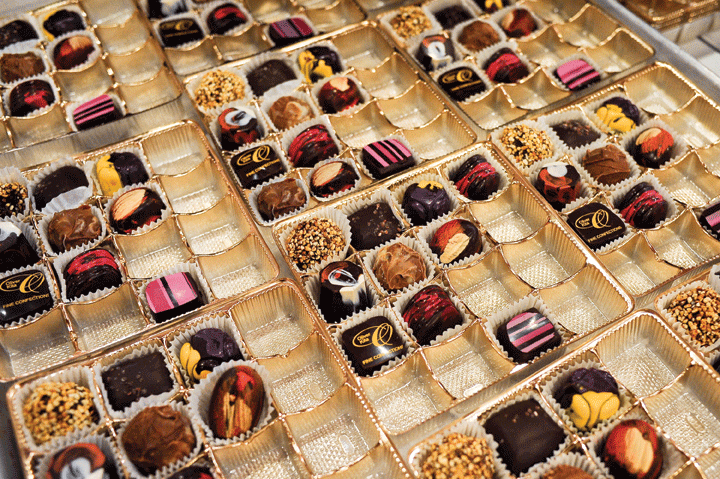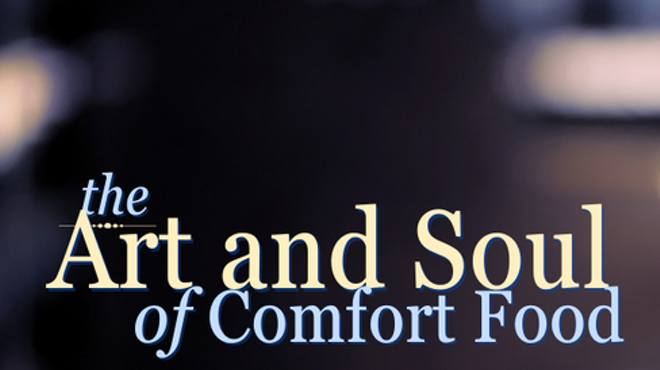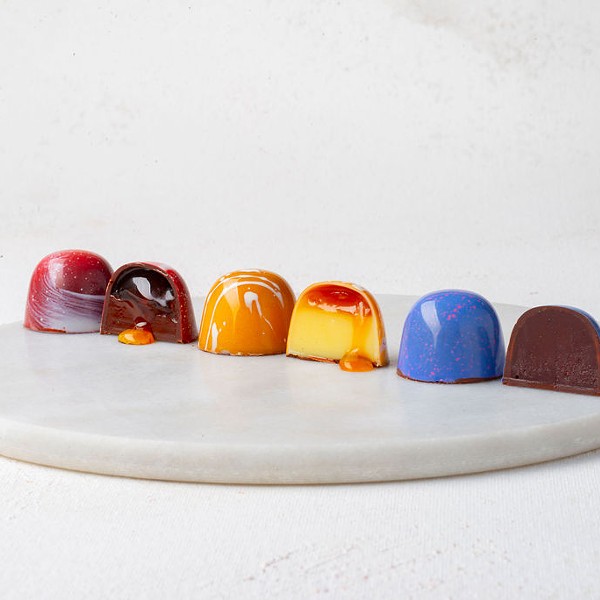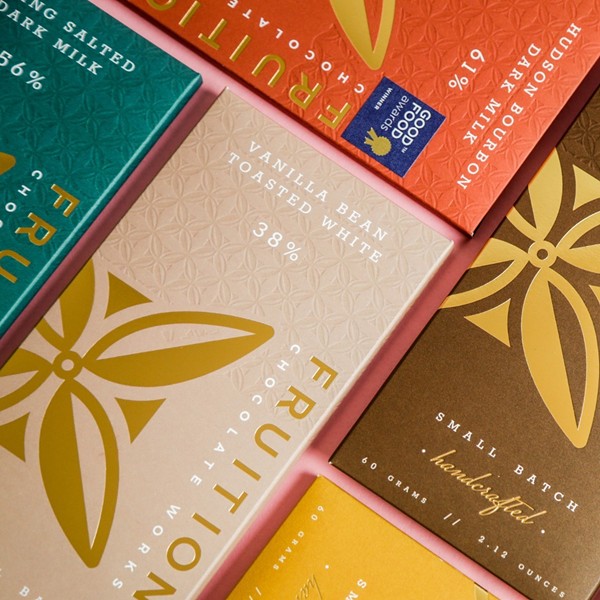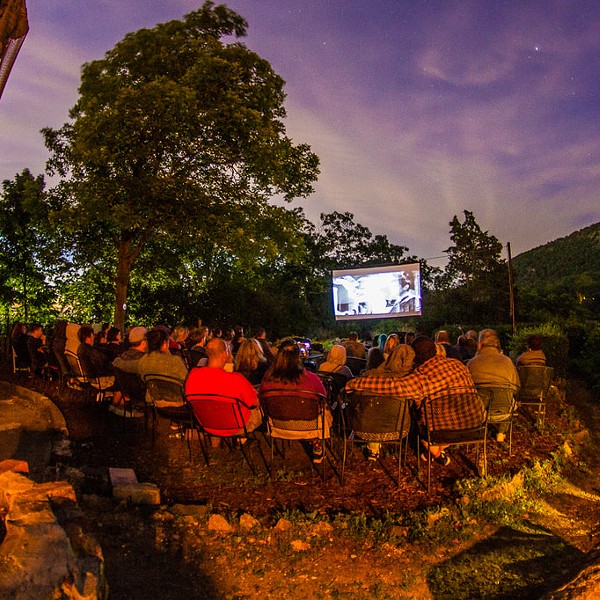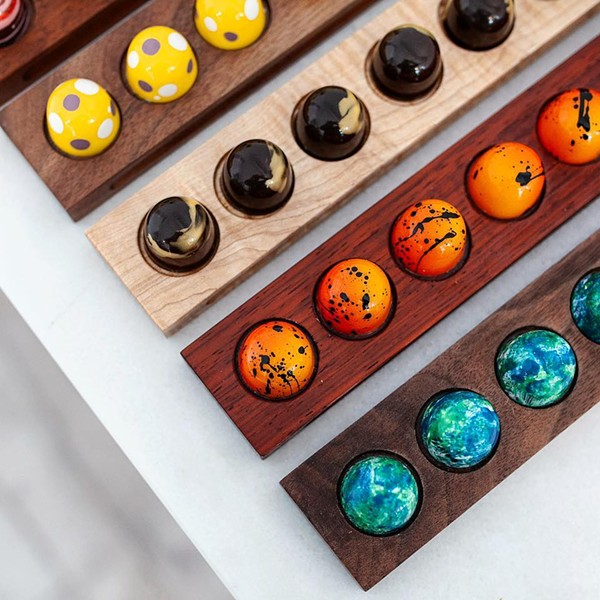Heart-Shaped Box
For the Love of Chocolate
[]
What happens when you eat a piece of chocolate?
When I ask about chocolate I’m not talking about a Mars bar. I’m referring to real chocolate: the pure stuff, the genuine article. It’s worth drawing a distinction. Real chocolate and a candy bar have a third-cousin, twice-removed degree of kinship with each other, and it’s barely worth asking what happens when you eat a candy bar—a fleeting minute of pure pleasure that becomes one more droning note in your indistinct sense memories.
There’s nothing wrong with candy bars. Even if it’s fleeting, the pleasure is still reliable, and it plugs us right into childhood, when the best pleasures were immediate and unsubtle.
But real chocolate is something else altogether, something refined, something people get fanatical about and devote vocations to.
So, what happens when you eat a piece of chocolate? It’s a complex answer that, depending on who you ask, might include science, the spirit, memory, and some of that good old immediate pleasure, too.
If you ask a scientist, you’ll be made to understand the physiological effects of chocolate. Chemicals called flavonoids, present in chocolate, increase blood flow and may stabilize blood pressure, as well as working a little moisturizing magic on the skin. Theobromine, which is heavily concentrated in chocolate, is a mood enhancer. And there are other compounds present, too: phenethylamine, linked to sexual arousal; anandamide, which produces euphoric feelings by working on the brain much like marijuana does. Chocolate also boosts serotonin levels, which theoretically helps alleviate depression. But that’s all pretty clinical stuff at a good remove from real experience, like trying to get at the magic of a piece of music by understanding how it affects your brain waves.
The Romanticist
If you ask Oliver Kita, owner of Oliver Kita Chocolates in Rhinebeck, you get an answer that straddles hard science and mystery: Chocolate is art, and to eat a piece of chocolate is to have, essentially, an artistic experience.
Kita moved to the Hudson Valley over 20 years ago to attend the Culinary Institute of America, operated the restaurant Heaven in Woodstock for more than a decade, and then became entranced by chocolate. He trained at prestigious schools in both Europe and Canada, under masters of chocolate making, and has operated his company ever since.
Oliver Kita Chocolates occupies a former firehouse in the center of Rhinebeck. The interior is whitewashed and spacious, with cases and shelves full of chocolates and baked goods, giving out to a wide workspace where a few employees pack the confections for display or shipping, and an enclosed kitchen beyond that. Kita himself looks a lot younger than his 54 years, which may lend a little credence to theories about chocolate’s physical benefits.
[image-2]
He’s a good talker, articulate and reflective, and one Friday afternoon he told me a story: “I have one really lovely customer who will get her box [of chocolate], she’ll go into her room—her children cannot come in the room—and she’ll have 15 minutes to herself with her book. She’ll eat a piece of chocolate and she’ll have her moment, for herself, and that’s kind of like her quick trip.”
The company’s motto is “Mind — Body — Chocolate Every Day.”
Kita says, “Our chocolate is like a work of art. It has the same joy and beauty as a work of art. You can have it every day.”
The experiences that come via confections like Kita’s Palet d’Argent—a piece of Venezuelan chocolate—or the smoke-infused, blood orange flavor of his Palet d’Opium have artistic origins too. “I draw my inspiration from museums around the world. We were just at the Art Institute of Chicago and I saw a pen-and-ink drawing of insects on the wall. And I said, ‘That’s a great Halloween idea—the insectarium.’ So we made edible bugs in a box.”
He continues: “If you look at some of the flavors, the flavor names of the chocolates are derived from the artist’s palette of colors. So there’s Vermillion Fruit, there’s Scarlet Caramel. I’m a Romanticist at heart.”
The Nostalgist
Over in Shokan, near the reservoir along Route 28, Bryan Graham, the owner of Fruition Chocolate, says that what happens when you eat a piece of chocolate is something of a flashback to childhood’s simpler, more unadulterated pleasures. “For me, it’s a nostalgic thing. I grew up eating chocolate and I just love it. Whenever I’d go out with my parents, I’d just beg them for candy bars.”
Pushing those nostalgic buttons isn’t a haphazard process. Consistent effects require solid knowledge and control. To achieve that control, Graham takes a complete DIY approach: He’s one of a handful of artisans that makes his own chocolate, bean to bar, entirely in his workspace.
[image-3]
Fruition stands in a small complex just off the highway next to a pizza joint and a few other anonymous businesses. Recently opened to the public for retail, the interior is sparse: a few shelves and a wood and steel deco counter stocked with chocolate bars and chocolate confections. The big work happens in the back.
Graham starts with a sack of cacao beans that he roasts in a convection oven. The beans are broken up and the shells separated from the nibs, which are the useful components of the bean. The nibs go into a grinder with sugar and a little cocoa butter, and over the course of a few days, 40-pound granite wheels crush and liquefy the mixture. The chocolate is poured into pans, aged for a few weeks, then remelted and formed into bars and confections.
The results are relatively straightforward. Most of that chocolate ends up in bar form, gradated by the percentage of cacao—60, 70, etc.—and the majority of those bars are just plain chocolate. There are some deviations, though, that touch on most people’s first chocolate experiences.
“We make milk chocolate. Not many bean-to-bar chocolate makers are doing milk chocolate. It’s considered a little déclassé. But I think a really well made milk chocolate can be a beautiful thing. That flavor, that melt-in-your-mouth creaminess.”
Graham is another Culinary Institute graduate and did his internship with master chocolatier Jacques Torres in Manhattan. After he graduated, he returned to the CIA to work in its Apple Pie Café, where one of his jobs was to figure out things to do with chocolate. He moved on to a pastry chef position at the Bear Café in Bearsville. Upon leaving the restaurant, he and his wife took a cross-country road trip and hatched the concept of Fruition, both as a chocolate-making and a confectionary concern. In addition to the bars, Graham has been developing a selection of confections such as house-smoked, chocolate-covered almonds and an olive oil and breadcrumb ganache coated with his own chocolate, among others.
Both chocolate making and confection making are equally consuming: “As a chocolatier, you need to know the fundamentals of perfect temper, working with colors, working with bold flavors, balancing flavors. With chocolate making, you have to understand the process and it uses a whole other set of equipment that most chocolatiers don’t have. It’s incredibly labor intensive, time intensive. It’s expensive to get started doing either one, but doing both is challenging.”
The Intensifier
Rae Stang, proprietor of Lucky Chocolates in Saugerties, finds that what happens when you eat a piece of chocolate is a moment of pure experience. When you take a bite of something like her sour lemon chocolate, there’s little else going on—you are bombarded with the flavor of it.
“I’m not subtle,” she says, sitting in the small retail area of the store, which pushes in on three sides with a crush of chocolates, candies, and toys. “I really like intense flavors. I found that most of the chocolates I ate in my life—even the fancy ones—you couldn’t really tell what they were. This is lemon? Okay, maybe, and they were all too sweet. I don’t like things that are really sweet, so I try and make things that have very intense flavors. If it’s fruity, it should be intensely fruity.”
Stang’s conversion to chocolate came about six years ago. “I was a cook; I did a lot of work at guest ranches and places like that out west. I have an art background, but I’ve always really liked food. I went to the CIA for a shorter class on professional baking. I wanted to revamp my career—I was getting older. And we had two weeks of confectionary, and it seemed really magical.”
Of these three chocolatiers, Stang is the most playful. She offers “grown-up versions” of Snickers and Milky Way bars, and says her PMS bar—potato chips, caramel, peanut butter sweetened with agave, and salt—is one of her best sellers.
Whether it’s Kita’s artistic approach, Graham’s earthiness, or Stang’s lighter-hearted take, all three are single-minded about ingredients: fair-trade and organic. Kita is one of the few chocolatiers anywhere who buys directly from the exclusive Valrhona company in France; Graham’s cacao comes from a fair-trade collective in Peru; Stang is on a constant shifting search: “I’m always looking for more sources. It’s hard to find fair-trade in this country that’s also organic.”
So what happens when you eat a piece of chocolate? Oliver Kita, Bryan Graham, and Rae Stang have different answers and approaches but make sure it’s a singular moment—and each offers an experience worth undertaking.







